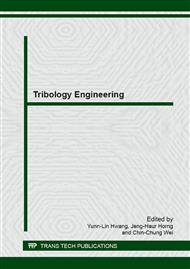[1]
W. W. F. Chong, M. Teodorescu, and N. D. Vaughan. Cavitation induced starvation for piston ring/liner tribological conjunction. Trib. Int., Vol. 44 (2011), p.483–497.
DOI: 10.1016/j.triboint.2010.12.008
Google Scholar
[2]
J. A. Greenwood and B. P. Williamson. Contact between nominally flat surfaces. Proc. Roy. Soc., Series A, Vol. 24 (1966), p.300–319.
Google Scholar
[3]
J. A. Greenwood and J. H. Tripp. The contact of two nominally flat rough surfaces. Proc IMechE, Vol. 185 (1970), 625– 633.
DOI: 10.1243/pime_proc_1970_185_069_02
Google Scholar
[4]
L. Kogut and I. Etsion. Elastic-plastic contact analysis of a sphere and a rigid flat. J. Appl. Mechanics, Vol. 69 (2002), p.657–662.
DOI: 10.1115/1.1490373
Google Scholar
[5]
R. L. Jackson and I. Green. A finite element study of elasto-plastic hemispherical contact against a rigid flat. Trans ASME, J. Trib., Vol. 127 (2005), p.343–354.
DOI: 10.1115/1.1866166
Google Scholar
[6]
W. W. F. Chong and M. De la Cruz. Elastoplastic contact of rough surfaces: a line contact model for boundary regime of lubrication. Meccanica, Vol. 49 (2014), pp.1171-1191.
DOI: 10.1007/s11012-013-9861-1
Google Scholar
[7]
M. De la Cruz, W.W.F. Chong, M. Teodorescu, S. Theodossiades, and H. Rahnejat. Transient mixed thermo- elastohydrodynamic lubrication in multi-speed transmissions. Trib. Int., Vol. 49 (2012), p.17–29.
DOI: 10.1016/j.triboint.2011.12.006
Google Scholar
[8]
W.W.F. Chong, M. Teodorescu, and H. Rahnejat. Mixed thermo-elastohydrodynamic cam-tappet power loss in low-speed emission cycles. Int. J. Engine Research, Vol. 15 (2014), pp.153-164.
DOI: 10.1177/1468087412461631
Google Scholar
[9]
W.W.F. Chong, S. Howell-Smith, M. Teodorescu and N.D. Vaughan. The influence of inter-ring pressures on piston-ring/liner tribological conjunction. IMechE Part J: J. Eng. Trib., Vol. 227 (2013), pp.154-167.
DOI: 10.1177/1350650112461579
Google Scholar
[10]
W. W. F. Chong, M. Teodorescu, and H. Rahnejat. Effect of lubricant molecular rheology on formation and shear of ultra-thin surface films. J. Phys., D: Appl. Phys., Vol. 44 (2011), p.165302.
DOI: 10.1088/0022-3727/44/16/165302
Google Scholar
[11]
H. G. Elrod. A cavitation algorithm. Journal of Lubrication Technology, Vol. 103 (1981), p.350–354.
Google Scholar
[12]
C. K. Buenviaje, S. R. Ge, M. H. Rafaillovich, and R. M. Overney. Atomic force microscopy calibration methods for lateral force, elasticity and viscosity. Mat. Res. Soc. Symp. Proc., Vol. 522 (1998), p.187–192.
DOI: 10.1557/proc-522-187
Google Scholar
[13]
B. J. Briscoe and D. C. B. Evans. The shear properties of langmuir-blodgett layers. Proc. Roy. Soc., Series A, Math and Phy Sci, pages 389–407, (1982).
Google Scholar


